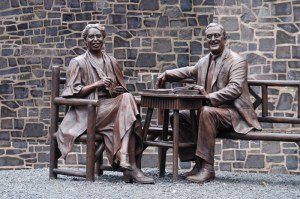
For whatever reason, I wasn’t sleeping well two weeks ago. When I booked our hotel for our trip to the Mid-Hudson for the first weekend in August, in my fatigued fog, I totally forgot that my wife had told me to secure a place for TWO nights and that she had even arranged for a cat sitter. I was just so happy that I finally remembered to book it at all. We had made this sojourn 1.5 hours south a few times, and it had always been one night. This time, though, we had added a couple of elements, so the extra time would have been helpful.
Instead, we headed out Saturday and went to Val-Kill, Eleanor Roosevelt’s home. There will be much more on this.
Then to Hyde Park to visit the Franklin D. Roosevelt Presidential Library and Museum. It was all but closed for repairs last year when we visited the mansion – though not TOTALLY closed, as the attendant at the locale properly noted – so the tickets we got last year for the site were still valid. I needed more time in the museum than The Daughter had to give; I got through the Depression era, but I really didn’t see the World War II stuff. Still, a great exhibit. I’ll go back some time, and it’s inspired me to want to see the other Presidential libraries, most of which are in the center of the country.
One thing that struck me at FDR’s library was a newspaper editorial cartoon of FDR and Congress rolling up their sleeves and getting to work on the nation’s problems together; THOSE were the days. Another was a poster chastising “the Jews” for taking the jobs of “white Christian men”; then again, some things never change.
We went to an annual party and The Daughter got to swim. Had a GREAT conversation with a minister and his social worker wife; we seemed to be on the same page in terms of social justice and the church’s role in same. But I was disappointed that my oldest friend from college was not present.
Finally, we went to our hotel. By this point, it was dark, and it was difficult to see, so we overshot it. FINALLY to bed, but one or more of the people in my room was snoring, and I got less than optimal rest.
Sunday morning, we went down to see what the hotel offered for breakfast. It was paltry: some fruit, hot chocolate, and instant coffee, and packets of oatmeal, which wasn’t so bad except there was no MILK and we would have had to use Coffeemate, a non-dairy creamer. We went out for breakfast, then checked out of the hotel and went to see Maria.
Maria Vezina is the sister of the late FantaCo cartoonist Raoul Vezina, who had died in November 1983, at the age of 35 of an asthma attack. I hadn’t seen her in nearly three decades. While she lives and works in New York City, she was up in the Mid-Hudson with TONS of boxes of Raoul’s stuff. I sorted out certain items for a possible project. She thought it would have taken me three hours, but I did it in 50 minutes; I knew what I was looking for. More details if this pans out.
Then we departed for the home of Fred Hembeck and his wife Lynn Moss. I met Fred back in February 1980 when FantaCo published his second collection of comic book-related strips. We made the sojourn to visit them for three or four years, then not for three years because of conflicts, then for the past two or three years. Fred and I have this shorthand way of talking that occasionally confounds my wife. Fortunately, she could go out with The Daughter to the pool. They made us a nice dinner, then we left for home.
I never realized how large one upstate county could be!
We stopped in New Paltz, my college town, to catch the Thruway, but, northbound, it was a parking lot, due to, as it turns out, an overturned tractor-trailer. So we took back roads to Saugerties, didn’t get to Albany until 9 p.m., and were exhausted.
After all that, I figured we’d follow that up with a nice quiet weekend. But the Daughter had a certificate for a FREE day at Great Escape, the Six Flags park about an hour north of here, and the coupon expired on August 11, so guess what WE did on Saturday, the 10th…




